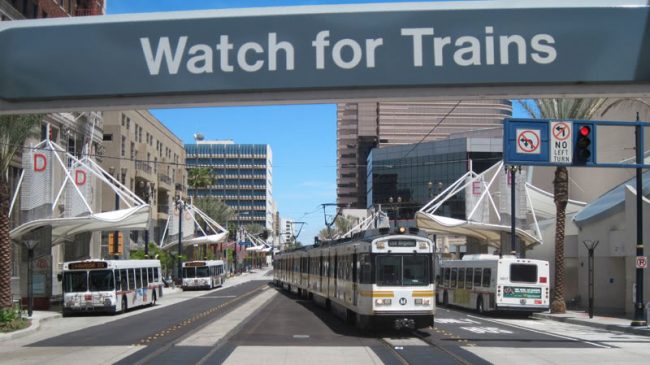Despite more people living and working in California, mass transit ridership continues to decline. The problem is particularly severe in Orange County, where transit ridership is down 30 percent since 2008.
The Eno Center for Transportation found that between 2014 and 2016, transit ridership dropped in all but seven of the country’s largest urban areas. Cutbacks in transit service are the top reason for the decline nationally. Rail cutbacks, such as running fewer trains per hour or closing the system earlier in the day, play a role. But most of the decline is due to decreasing bus services. Between 2009 and 2014, transit agencies decreased bus miles of travel by 5.2 percent.
The Mineta Transportation Institute found that when you control for variables such as gas prices and other transportation options, bus frequency is the best predictor of ridership. Put simply, decreasing bus service substantially decreases ridership, even for buses that were largely empty.
Some politicians propose new rail services as alternatives. But replacing these bus lines with rail lines provides worse service to low-income users, who may depend on transit to get to their jobs. Dallas and Houston both built light rail systems to replace their existing bus lines. For several years, despite spending millions of dollars on new equipment, the new systems carried fewer passengers than the original bus-only systems.
Fortunately, there are several steps that can be taken to cost-effectively improve transit service, including four immediate steps that agencies should take. First, transit agencies should use intelligent transportation systems technology to reduce bus travel times and make them more appealing. Installing transit traffic signal priority technology, for example, gives green light traffic signals to buses and increases bus speeds by 20 percent.
Second, Orange County Transportation Authority leaders could update the bus network to reflect today’s work and travel patterns. While some routes were changed in 2015, the entire network should be updated. Yes, this puts the transit agency in a tough political spot because existing customers will complain to local elected officials about any route changes. But at very little cost, Houston redesigned its bus network’s routes, eliminating some lines and substantially increasing service on weekends. As a result, weekend ridership increased by almost 50 percent.
Third, OCTA and other agencies can partner more aggressively with private transit and technology companies. OCTA has already partnered with Lyft to provide rail hiding services on two routes the agency eliminated in San Clemente. Uber provides paratransit service for many regions across the country. And many transit agencies are moving to a model in which they provide service on high ridership lines while private bus services and technology companies provide fixed-route service on other lines.
Finally, over the long-term, OCTA will need to evolve. The biggest opportunity is to transition from a service provider to a mobility manager. We don’t know what the future holds for self-driving cars and buses, or even Elon Musk’s proposed hyperloop, but in the coming decades, transit services may become driverless and completely different from today’s transit. OCTA’s long-term vision should be to match transit customers’ needs with service providers, not operating buses.
Paratransit services for those with disabilities and bus service public-private partnerships are springing up in cities and are a start, but big picture mobility management is about much more. In the future, transportation agencies will oversee multiple transit providers, each of which will operate different routes and likely use different technology — perhaps self-driving vehicles, automated shuttles, or regular routes using Uber and Lyft vehicles.
Many transit systems are suffering lower ridership numbers, high operating costs and lack the revenue streams to self-fund upgrades, but OCTA and other agencies have the opportunity to start reinventing themselves by utilizing technologies that can give riders real-time information and synchronize their traditional transit services with ride-sharing and tech companies to make it easier and faster for riders to get where they want to go, when they want to go there.
Baruch Feigenbaum is assistant director of transportation policy at Reason Foundation. This article originally appeared in the Orange County Register

